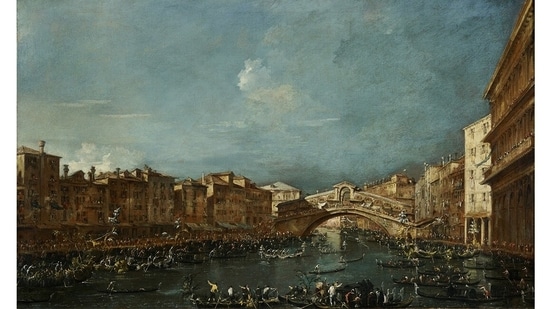Photos: Bridges that appear in famous works of art
Published on Sep 10, 2021 02:14 PM IST
They’ve been backdrops (behind the Mona Lisa), taken centrestage (in Monet’s Waterlilies), sometimes they’ve held up entire scenes. Take a look at masterpieces featuring bridges big and small.
1 / 8

Published on Sep 10, 2021 02:14 PM IST
Regatta at the Rialto Bridge (1770-9), an oil-on-canvas work by Francesco Guardi (1712–93) features the Rialto Bridge, one of the top tourist attractions in Venice. Few know that it replaced a rickety wooden version in 1591 and that people feared the new one would collapse under its own weight. Guardi captures the morning light and shadows, the dozens of human figures participating in the boat race and Venice’s distinctive architecture in the background.(Courtesy Museum of Fine Arts, Houston, USA)
2 / 8

Published on Sep 10, 2021 02:14 PM IST
Devil’s Bridge is one of the most popular paintings by Caspar Wolf (1735–1783). It depicts the bridge in the Saint Gothard Pass across the Schöllenen Gorge, linking northern and southern Switzerland. The regions were connected by a wooden bridge since the 1200s. This work was probably painted in 1775 – when the bridge was wide enough to allow a carriage to pass, boosting trade and tourism greatly.(Wikimedia Commons)
3 / 8

Published on Sep 10, 2021 02:14 PM IST
Frederic Edwin Church (1826–1900) painted Pichincha, named for the Ecuadorean volcano in the distance, in 1867. He’d visited the South American country a decade earlier, but clearly his memory was hazy. The palm trees that feature in this work could not have grown on the high Andean plain. The suspended bridge and the woman gingerly travelling across it, however, would have been a common sight.(Courtesy Philadelphia Museum of Art, USA)
4 / 8

Published on Sep 10, 2021 02:14 PM IST
Argentina’s most famous painter, Benito Quinquela Martín (1890-1977), largely painted scenes from the waterfront of his native home in La Boca, the port district of Buenos Aires. Abandoned at birth and adopted by a dockworker, he was drawing with bits of charcoal before he could read or write. This work, also called Puente en La Boca, is one of his early works, bringing a sense of poetry to the everyday life and work at the docks in the shadow of the Puente Transbordador.(Courtesy Christie's)
5 / 8

Published on Sep 10, 2021 02:14 PM IST
Perhaps the single best-known work by Norwegian Expressionist artist Edvard Munch (1863-1944). He painted The Scream in 1893, explaining later that the work was borne out of a walk he’d taken at sunset, when the sky has turned a blood red and he sensed an "infinite scream passing through nature". Art historians have determined that the bridge the figure is standing on might be a fjord overlooking Oslo. It’s unlikely there was a bridge there.(Courtesy Munich Museum, Oslo, Norway)
6 / 8

Published on Sep 10, 2021 02:14 PM IST
French impressionist Claude Monet (1840-1926) was a passionate horticulturist. In 1893, he bought an estate with a pond in Giverny, setting up a water-lily garden and bridge that inspired many of his most famous works. This one, from 1899, is in an unusual vertical format, and includes a reflection of the bridge in the pond too.(Couertesy Metropolitan Museum of Art, USA)
7 / 8

Published on Sep 10, 2021 02:14 PM IST
A lesser-known work from the Thirty-six Views of Mount Fuji, woodblock prints by Katsushika Hokusai (1760–1849). This one, Under the Mannen Bridge at Fukagawa, was created between 1830–33 when rivers and canals crisscrossed Edo. Bridges, then were especially useful. Hokusai focuses on the structural beauty of the Mannen Bridge over the Onagi River, and the bustling life around it. Yes, that is Fuji on the horizon.(Courtesy Mary A. Ainsworth Bequest, 1950. Allen Memorial Art Museum, Oberlin College, USA)
8 / 8

Published on Sep 10, 2021 02:14 PM IST



